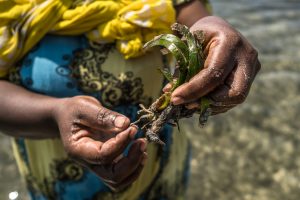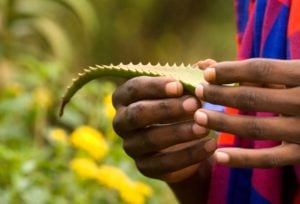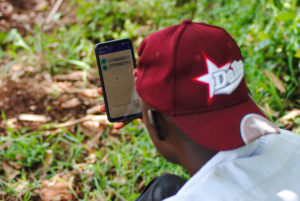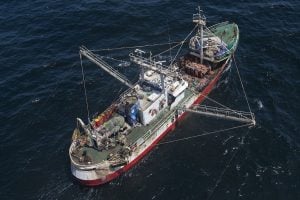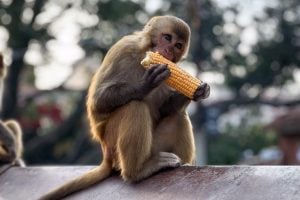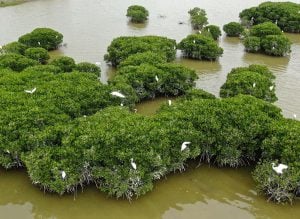It is midmorning next to the incomplete Thwake dam in southern Kenya. The hot sun has forced most from Kisayani village in Makueni County to take cover under dwarf shrubs and acacia trees.
Rhoda Katumbi Kele, a 57-year-old village elder, is busy tending to a small patch of vegetables.
Among her livestock grazing in the nearby field are two donkeys that she uses to carry water from Thwake River, seven kilometers away, to irrigate her vegetables and to use at home.
Katumbi Kele tells Dialogue Earth that once the dam is finished, she plans to increase her vegetable cultivation.
“For now, I grow vegetables on a small portion of land for domestic consumption because of water shortage,” she tells Dialogue Earth.
“But once the water becomes available, I will commercialise my venture for sale in our nearby Mavindini market.”
Drought-induced food insecurity
The households under Katumbi Kele’s stewardship bore the brunt of a drought between 2022 and 2023 that dried up almost 95% of Kenya’s water pans (man-made reservoirs that capture and store rainwater).
The building of the Thwake multipurpose dam began in 2018 and has nurtured hopes that food security will be achieved in the village.
The dam is designed to provide water for drinking, irrigation and 20 megawatts of hydropower. Despite delays, it looks likely to be completed this year, according to an engineer involved in the project consulted by Dialogue Earth.
Once finished, it is projected to hold 688 million cubic metres of water. The project is being built by the China Ghezhouba Group Company and is jointly funded by the African Development Bank and Kenyan government. The reported cost is KES 81.89 billion (USD 634 million).
Twenty-three of Kenya’s 47 counties, including Makueni, are considered arid or semi-arid. Rain did fall late last year, during the shorter of the two annual rainy seasons. However, malnutrition linked to insufficient rain and failed harvests remains a grave issue. Close to 850,000 children aged between 6 and 59 months in these arid and semi-arid counties are still in need of treatment for acute malnutrition, according to a recent report by the National Drought Management Authority.
The people of Makueni depend upon agriculture for food and income generation. But climate change is a major challenge – a 2016 climate risk profile of Makueni by the agriculture ministry found maize yields had declined since 1994.
The profile indicates that in 2013, 60-90% of crops failed in Makueni, largely due to drought. During that year, yields of mainstay crops – maize, cowpea and greengrass – dropped by 42%, 74%, and 79% respectively, causing about 60,000 people to depend upon food relief .
Titus Thusi, another farmer from Kasayani village, says he had only eight of his 30 goats left to sustain him after the 2022-2023 drought. The 39-year-old father of three was forced to sell the others at a throwaway price.
“When drought came, they were all weakened by lack of pasture,” Thusi says. “I had to sell them before they succumbed.”
“Once the dam is complete, I will go back to growing my flock even bigger because there will be water for them to drink. I can also use the same water to grow pasture for my livestock,” he adds.
Several other farmers in the village tell Dialogue Earth they are also hoping to increase their farming output once the dam is operational.
Plans for large-scale irrigation
According to Joyce Mutua, the government official in charge of agriculture in Makueni, 1,500 acres (600 hectares) of agricultural land in the county is at different stages of irrigation development. The Thwake dam will enable another 100,000 acres (40,000 hectares) to be put under irrigation, she says.
Mutua says the dam will present an opportunity to diversify food production, incorporating sorghum, cowpeas, and French beans, for the local market and for export.
There are also plans underway to set up a facility for distributing farming essentials like fertilisers, and a hub for extension officers to train good farming practices, including the use of biopesticides.
“We will also set up irrigation water users’ committees in the areas that will be under irrigation, to ensure that water is distributed and used adequately to avoid any conflict,” Mutua says.
The county has also set up a fish-landing site and a cold store in Thwake, and equipment for fishing from the dam’s reservoir. The hope is to turn Makueni into a fisheries county, she explains.
All these efforts are geared towards moving Makueni away from any reliance on food relief.
A delayed project
In November 2022, President William Ruto promised to build 1,000 dams across the country to boost agriculture and food security. However, the delivery of this promise has faced a myriad of challenges, including governmental cost-cutting programmes and reduced funding from China, the latter having supported several large infrastructure projects in Kenya.
Regarding the Thwake dam, last year the subcontractor JTG Enterprises, which had been involved in excavation for the dam, successfully sued China Gezhouba for breach of contract. Despite these grievances, the dam reportedly remains on track for completion later this year.
There have been other hurdles, too. According to Zacharia Njeru, the minister for water, irrigation and sanitation, the project previously hit a snag when the contractor paused construction, citing delays in the disbursement of government funds. He says construction challenges have included the rising cost of materials and unanticipated ground conditions.
Njeru says the embankment of the dam will be ready by June 2024 – ultimately confirmed by Gezhouba’s parent company China Energy Engineering Corporation on 26 June – and expects completion before the end of the year.
Dialogue Earth spoke to Sao Alima, a site engineer on the project and secretary at the ministry of water. He mentioned several other challenges that the dam contractor has faced.
“While we were digging the riverbed after diverting the river, we realised a weak foundation that we didn’t notice during hydraulic investigation, which could not hold the dam embankment,” Alima says. “We had to dig further than expected to reach a firm foundation for a stable embankment, which delayed the construction.”
Alima echoed Njeru in lamenting the slow pace of the government’s finance disbursement, saying the contractor was forced to pause construction until funds were made available to pay workers.
The geopolitical landscape has further complicated matters. Alima explained how the war in Ukraine has disrupted the supply chain for explosives, a crucial component for blasting through rock during the dam’s construction.
Alima adds that the Thwake dam is now 92% complete.
From drought to flood
Alima sees the project, and others like it across the country, as a potential silver bullet for the government’s professed ambition to combat the vagaries of rain-fed agriculture: climate change, Alima says, has rendered rainfall patterns increasingly unreliable, with periods of drought increasingly punctuated by devastating floods – as Kenya recently experienced.
From March until early May, heavy rains plagued East Africa. Indeed, on 2 May, a Kenyan government body warned people to stay away from Thwake dam.
“Police in Kathonzweni, Makueni County are cautioning members of the public that levels of water at Thwake dam are rising rapidly. The intake tunnel is submerged, the guard rails destroyed and the Makueni bridge engulfed by raging waters,” read the government warning.
Kenya, Tanzania and Burundi were hit particularly hard by the rains. Kenya alone reported at least 289 deaths and hundreds of thousands of displacements. President William Ruto described the deceased as “victims of climate change”.
For Alima, dams are a vital defensive weapon in this struggle. When contacted by Dialogue Earth following these floods and the government warning, he downplayed concerns over Thwake’s safety: “The dam is built on a firm foundation … the face of the dam will also be reinforced by concrete to further strengthen it.”



